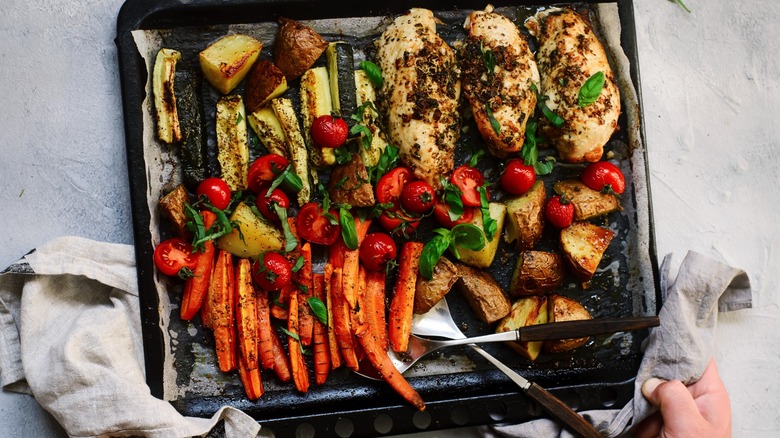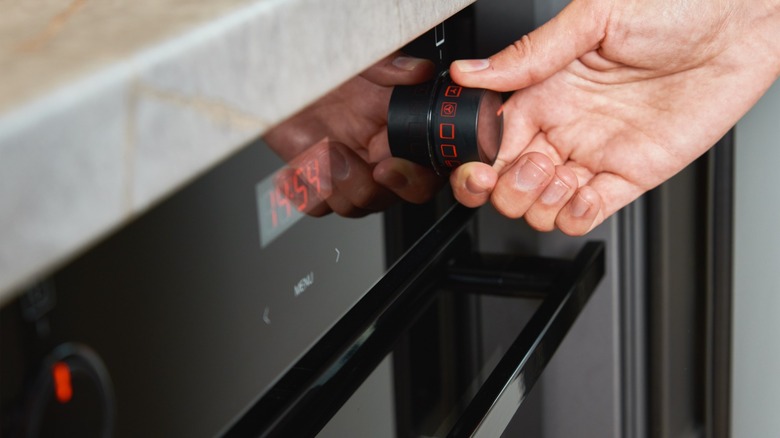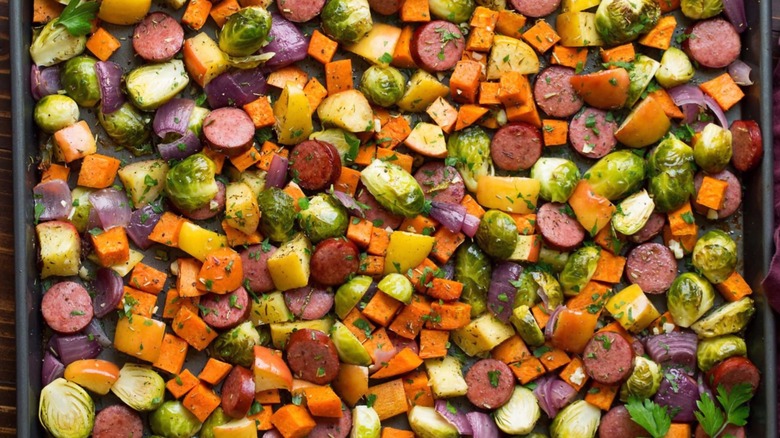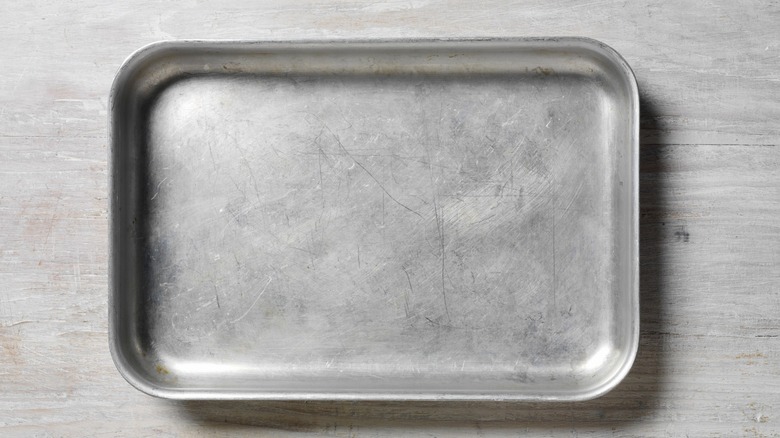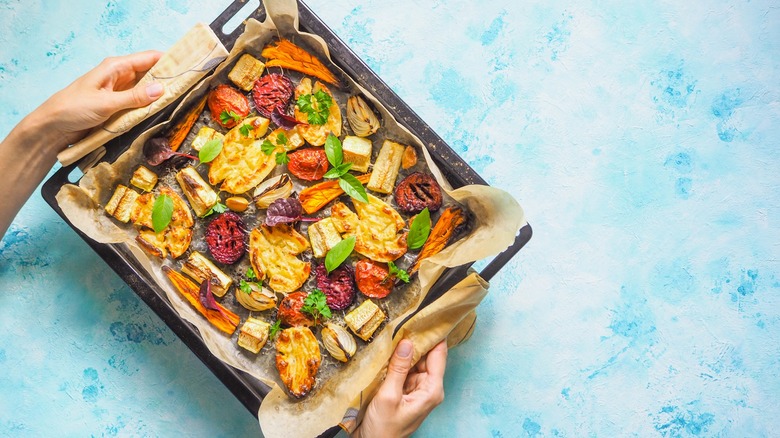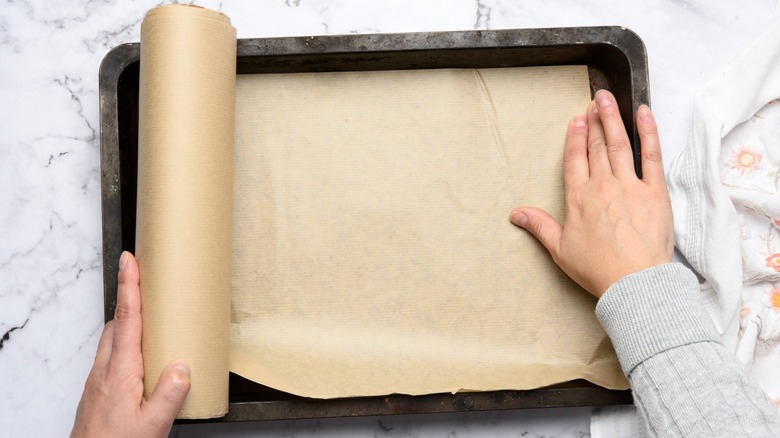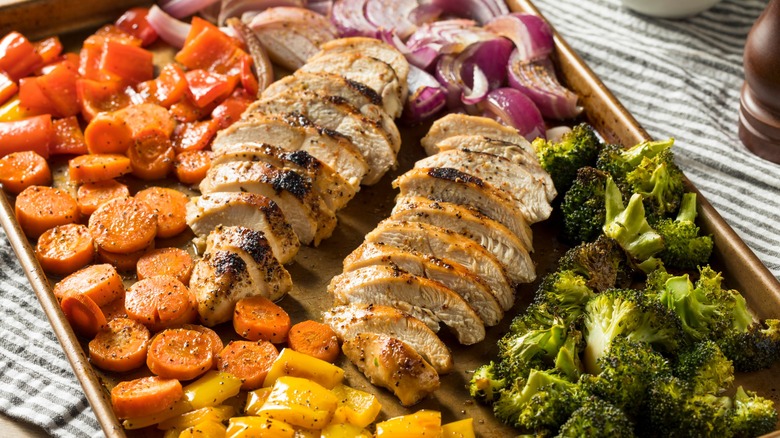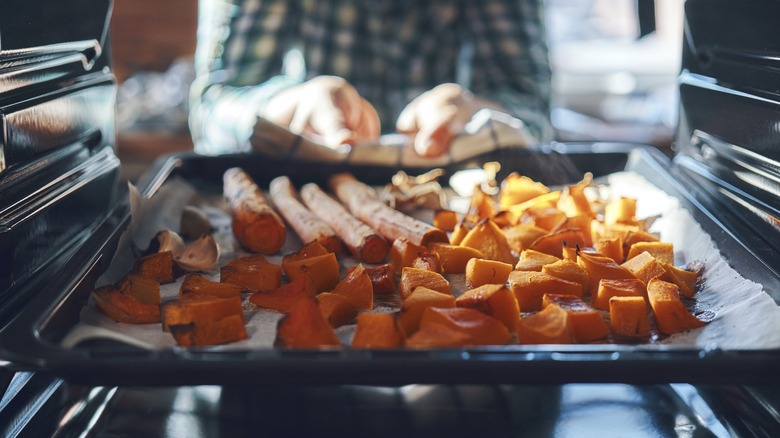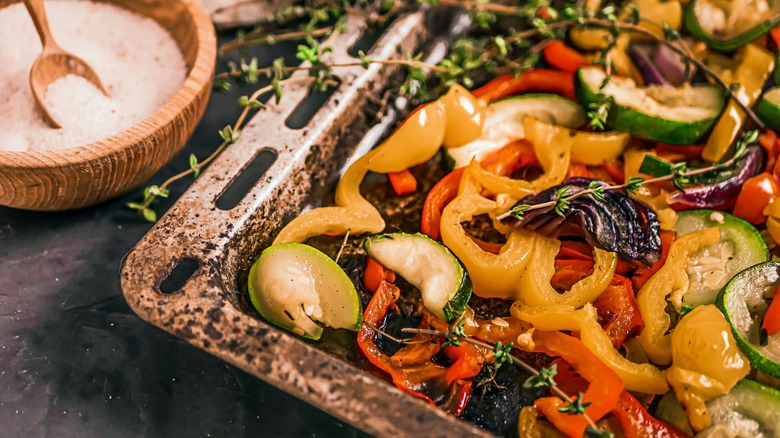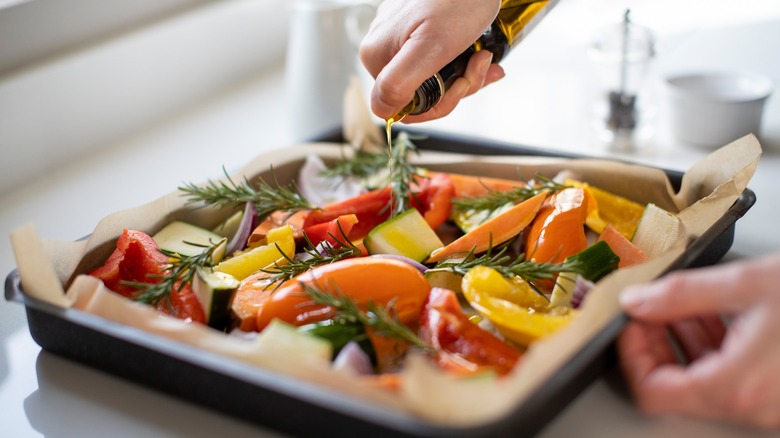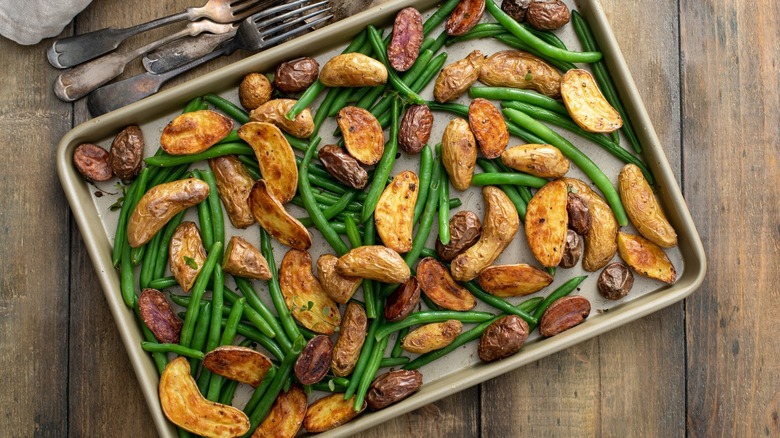11 Mistakes You're Making With Sheet Pan Dinners
Sheet pan dinners have become a staple in many households due to their convenience and aesthetic appeal. Not only are they a great way to make an appetizing dinner with minimal clean-up, but the allure of sheet pan recipes also lies in their simplicity and versatility, offering both novice and experienced home cooks a way to create a wide range of flavor-packed dishes. However, despite the apparent simplicity of tossing ingredients onto a single pan and letting the oven work its magic, there are common mistakes that can turn your sheet pan dinner from delectable to disastrous.
Let's take a closer look at the missteps you might be making with your sheet pan dinners and how to correct them with some tips that will help you elevate your one-pan meals to new heights of flavor. Whether you're a seasoned sheet pan enthusiast or just getting started, read on to discover how to avoid these pitfalls and make every sheet pan dinner a memorable success.
1. Neglecting to preheat the oven
Preheating the oven is an important step before cooking a sheet pan dinner. If you skip this step, it can significantly impact the outcome of your dish. Preheating will ensure an even and consistent cooking temperature as soon as you put your recipe into the oven. Without preheating, the food will start cooking at a lower temperature, leading to uneven results, longer cooking times, and potentially undercooked or overcooked portions. This can not only be a food safety issue but it can also result in varying levels of doneness and texture.
Because you let out a good amount of heat when you first open the oven door, it may even be a good idea to preheat it at a higher temperature than what the recipe calls for then turn the oven down once the food is in. Preheating also allows the food to caramelize properly. When you place your ingredients in a preheated oven it creates a beautiful brown crust that locks in tender moisture within. This adds depth of flavor and enhances the visual appeal of your sheet pan dinner.
2. Overcrowding the pan
When you load all of your ingredients onto the sheet pan, be sure not to overcrowd it. Overcrowding the pan will hinder proper airflow and heat distribution. When ingredients are tightly packed the hot air won't circulate as much around the ingredients which may result in some portions cooking faster than others.
This will not only cause inconsistency but could also cause your ingredients to steam instead of roast. That's because the excess moisture can prevent browning and crisping, resulting in soggy ingredients that lack the roasted and caramelized textures you want in a sheet pan dinner. Rachael Ray advises you to give your ingredients some breathing room to avoid accidentally steaming them. Spacing out vegetables is also one of Ina Garten's tips for perfecting your roasting game. So listen to the experts and take the extra time and effort to space out your ingredients properly, or use multiple pans when overloaded.
3. Skipping the sheet pan preheat
Another great way to prevent steaming your ingredients is by preheating your pan. A preheated sheet pan will ensure that the moisture in the ingredients immediately start to evaporate, preventing them from sitting in their own juices for too long. This will promote the browning and caramelization process which are essential for achieving the desirable textures in a sheet pan dinner. It will also help with cooking everything more evenly, as the ingredients will start to warm on all sides more quickly than if they were on a cold pan when placed in the oven.
Preheating the pan also reduces the time it takes to cook your meal which not only saves you time and money on your energy bill but faster cooking also means ingredients spend less time in the oven which will better preserve the vegetables' natural flavors and nutrients. In short, preheating your pan is a simple practice that can elevate the overall quality of your meal.
4. Not cooking at a high enough temperature
For the same reason that preheating your oven and preheating your pan is important when making sheet pan dinners, cooking at high temperatures will continue to ensure that your ingredients will get that perfect caramelized coating. This is especially important when roasting vegetables are involved. There's a good reason to make sure your roasted vegetables are extra-charred. It will give you that distinctive toasty flavor and crunchy exterior that you'll want as an added flavor boost in your sheet pan dinner.
Most sheet pan recipes will call for high oven temperatures, typically between 400 F and 425 F. These temps will promote that desired rapid browning, adding those depths of flavor and a visually appealing golden color to your ingredients. Cooking at high temperatures also significantly reduces cooking time. Again, this not only saves you time in the kitchen but will preserve the nutritional content of your ingredients.
5. Failing to take measures to prevent sticking
The one thing that can absolutely ruin the appearance and aesthetic appeal of your sheet pan dinner is the ingredients sticking to the pan. Preventing sticking when cooking sheet pan dinners is crucial to ensure that your ingredients cook evenly and that the final dish retains its appetizing appearance.
There are several ways you can make sure this kitchen disaster doesn't happen to you. The most common way is lining your sheet pan with parchment paper which will create a barrier between the ingredients and the pan. This is the easiest way, but there is a downside to using parchment paper. Because parchment paper is heat-resistant, it could cause a heat barrier between your ingredients and the pan that prevents the ultimate browning. However, flipping the ingredients during the roasting process can help with this. If you're out of parchment paper, the best substitutes include aluminum foil, cooking spray, or using nonstick sheet pans.
6. Using unevenly sized ingredients
The trademark of a sheet pan recipe is its assortment of ingredients that can include various vegetables, sausages and other protein, or even gnocchi. When working with so many ingredients it can be challenging to ensure they all cook evenly. For even roasting, considering the size of the pieces you're cooking is important. When ingredients are of the same size, they will cook at a consistent rate which will minimize the risk of overcooked or undercooked components. Chopping everything at the same size will also enhance the visual presentation of the meal, making your sheet pan dinner look more appetizing and professional.
The only possible exception to the chopping evenly rule may be if you are certain that some ingredients will cook faster than others. But if that's the case, it's better to use separate trays and stagger the cook times than to have various shapes and sizes, as we will further dive into below. That way, the aesthetic appeal is not lost.
7. Failing to consider cooking times
As we mentioned above, working with so many different ingredients is often tricky. Of course the appeal of sheet pan dinners lie in the simplicity of tossing everything onto one pan and cooking them all together. But there are times when that simplicity won't necessarily yield the best result. Inevitably, some ingredients will take longer to cook than others. So what's the best solution?
One option is to use separate sheet pans. Put the ingredients with different cooking times in their own individual sheet pans so you can remove each one as soon as it reaches the desired doneness, even if the others require more time. This approach not only ensures precision but also provides more space for each ingredient to roast effectively. Alternatively, if you prefer the convenience of using a single sheet pan and wish for all your ingredients to finish at the same time, then the best way to roast different vegetables together is to stagger the addition of ingredients. Start by placing those that need more time in the oven first. After they've had a chance to roast for a bit, temporarily remove the pan from the oven and add the remaining ingredients.
8. Not seasoning enough
When preparing a sheet pan dinner, the final outcome should be anything but bland and boring. While many vegetables have a lovely natural flavor, you need to salt before roasting in order to make them taste even better. Omitting salt or adding it after cooking won't get you the same delicious results. Seasoning your ingredients in advance allows the salt to permeate more deeply, enhancing both the flavor and crispy texture of vegetables without making them excessively salty.
Beyond salt, don't be afraid to add complementing herbs and spices to your sheet pan meal. Of course black pepper is always essential, but some great spices to always have in your pantry and ready to use include cinnamon and ginger which can make an unexpected but comforting addition to dishes with roasted carrots. Cayenne or red chili flakes are always a great option to spice things up. Many sheet pan dinner recipes will also call for the addition of fresh herbs which will add an aromatic aspect to the meal. Just remember that when using fresh herbs instead of dried, they should be added late in the cooking process or even afterwards as a final garnish.
9. Drowning your ingredients in too much oil
Using too much oil in your sheet pan dinner can negatively impact the end result, so be sure to practice restraint and moderation when it comes time to drizzle and toss your ingredients. Excessive amounts of oil can result in a dish that feels greasy and heavy, which will overshadow the natural flavors of your meal. This may also lead to your ingredients turning soggy, preventing them from achieving the desired crispness or caramelization.
How much oil you should be using depends on the amount you're roasting but a good rule of thumb is to measure out one tablespoon and start there. Or alternatively, dry roasting is an option, a technique that could bring out unexpected flavors in certain vegetables like summer squash. But for the most part, using just the right amount of oil in your sheet pan dinner will enhance the flavor and will help to prevent sticking. Just remember: moderation is key.
10. Using the wrong type of pan
The type of pan you should use for a sheet pan dinner is evident from the name of the dish itself. You should definitely avoid using a casserole dish as it will likely cause your ingredients to steam, resulting in a mushier meal. When preparing a sheet pan dinner, always opt for the classic sheet pan. But what specific kind of sheet pan should you be using? Addressing this question is crucial to ensure your recipe turns out as intended.
If your baking sheets are warping or not lasting very long, it might be time to invest in higher-quality ones. The best kind of sheet pan to use are ones made from aluminum. This material is the best option because it can withstand high heat and is an excellent heat conductor, meaning it will also distribute heat more evenly. Just be sure to clean them by hand to avoid rust and scratches.
11. Neglecting to monitor the cooking process
While it's true that sheet pan dinners are made to be effortless, that doesn't mean that once you put them in the oven, you can just sit back and relax and wait. During the cooking process, there are a couple of things you need to keep an eye on and do if you want to get the best result possible. While it is important to keep the oven door shut and the heat locked in, you should be rotating your pans at least once. Rotating the pan will ensure even airflow and create a more balanced roast.
Also don't forget to toss the ingredients while you're at it. Remove the pan from the oven at the halfway point and carefully toss with a silicone spatula or wooden spoon (metal ones may be too rough and affect the overall look). This will further ensure that you get the best, most evenly roasted sheet pan possible.
